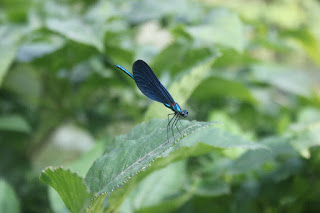Anyone who meets me knows within a few days that I'm obsessed with birds, and now you do too. They're my favorite animal, and I must have been one in a past life. As a result, not long after moving to Tanzania, I started receiving invitations to go bird-watching. This weekend, I was finally able to join a group of PROTS students in journeying to Maji ya Chai to watch birds--kuangalia ndege.
PROTS stands for the Professional Tourguide School. Since Tanzania hosts a robust tourism industry, many students after secondary school choose to study all things related to the profession, including business aspects as well as geography and ecology. My friends who invited me were going with a group of their classmates to put their bird-watching skills into practice.
We traveled all the way to Maji ya Chai, a good hour's ride outside of town, on the daladala. The name Maji ya Chai means "Tea Water," and the area is named this way because its river is home to water with a dark brown color like tea. Once I got there, I knew I'd have a great day stalking birds. After pouring out of the daladala, the students started pulling out their binoculars and Birds of East Africa manuals, my new favorite book without a doubt. Being surrounded by at least eight copies of it was amazing. At any point during the trip, I could look at any bird of East Africa I pleased and learn about its appearance, habitat, mating call, and life cycle.
In Maji ya Chai, I saw the following birds: emerald-spotted wood-dove, ring-necked dove, red-eyed dove, three-banded plover, brown-breasted barbet, cardinal woodpecker, African black-headed oriole, white-headed buffalo-weaver, taveta golden weaver, Peter's twinspot, grey-headed kingfisher, malachite kingfisher, bronze mannikin, white-browed coucal, common bulbul, sacred ibis, hadada ibis, hamerkop, tropical boubou, long-tailed fiscal, common fiscal, yellow white-eye, African hoop, and many, many more. (Admittedly, I sat with my tour-guide friend while writing this post in order to remember all them. Now you can procure a copy of Birds of East Africa and check them out for yourself! Then mail your copy to my house please.)
Of all the birds I've seen so far in Tanzania, my favorite is the superb starling. Its wings are a bright, shiny blue color to ward off predators. I think I'm drawn to small blue shiny things. I looked back at some pictures I had from traveling to Albania this summer and found the one below, with a shiny blue dragonfly. I had an earlier picture on my phone of the superb starling, so I've added that since the ones I saw this weekend were too far away to photograph effectively. Here's a side-by-side comparison of blue shiny things.
Never have I been in the same place as so many other bird lovers at once. It was great. I'm glad I got to enjoy a nice weekend activity so different from work. In contrast, I'm working this Saturday morning. It's my turn in a rotation of our employees to staff the office for half the day, in case any customers come in with needs for their solar home systems or any new faces appear with an interest in our services. After work, I might be able to join up with bird-watching friends for another trip. Fingers crossed!







No comments:
Post a Comment